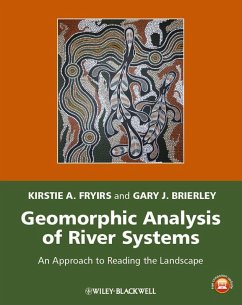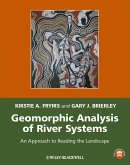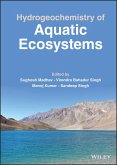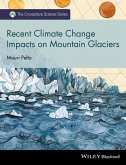Geomorphic Analysis of River Systems (eBook, PDF)
An Approach to Reading the Landscape


Alle Infos zum eBook verschenken

Geomorphic Analysis of River Systems (eBook, PDF)
An Approach to Reading the Landscape
- Format: PDF
- Merkliste
- Auf die Merkliste
- Bewerten Bewerten
- Teilen
- Produkt teilen
- Produkterinnerung
- Produkterinnerung

Hier können Sie sich einloggen

Bitte loggen Sie sich zunächst in Ihr Kundenkonto ein oder registrieren Sie sich bei bücher.de, um das eBook-Abo tolino select nutzen zu können.
Filling a niche in the geomorphology teaching market, this introductory book is built around a 12 week course in fluvial geomorphology. 'Reading the landscape' entails making sense of what a riverscape looks like, how it works, how it has evolved over time, and how alterations to one part of a catchment may have secondary consequences elsewhere, over different timeframes. These place-based field analyses are framed within their topographic, climatic and environmental context. Issues and principles presented in the first part of this book provide foundational understandings that underpin the…mehr
- Geräte: PC
- mit Kopierschutz
- eBook Hilfe
- Größe: 40.34MB
![Geomorphic Analysis of River Systems (eBook, ePUB) Geomorphic Analysis of River Systems (eBook, ePUB)]() Kirstie A. FryirsGeomorphic Analysis of River Systems (eBook, ePUB)50,99 €
Kirstie A. FryirsGeomorphic Analysis of River Systems (eBook, ePUB)50,99 €![Pollution of Lakes and Rivers (eBook, PDF) Pollution of Lakes and Rivers (eBook, PDF)]() John P. SmolPollution of Lakes and Rivers (eBook, PDF)61,99 €
John P. SmolPollution of Lakes and Rivers (eBook, PDF)61,99 €![Hydrogeochemistry of Aquatic Ecosystems (eBook, PDF) Hydrogeochemistry of Aquatic Ecosystems (eBook, PDF)]() Hydrogeochemistry of Aquatic Ecosystems (eBook, PDF)144,99 €
Hydrogeochemistry of Aquatic Ecosystems (eBook, PDF)144,99 €![Braided Rivers (eBook, PDF) Braided Rivers (eBook, PDF)]() Braided Rivers (eBook, PDF)152,99 €
Braided Rivers (eBook, PDF)152,99 €![Coherent Flow Structures at Earth's Surface (eBook, PDF) Coherent Flow Structures at Earth's Surface (eBook, PDF)]() Jeremy G. VendittiCoherent Flow Structures at Earth's Surface (eBook, PDF)116,99 €
Jeremy G. VendittiCoherent Flow Structures at Earth's Surface (eBook, PDF)116,99 €![Sediment Cascades (eBook, PDF) Sediment Cascades (eBook, PDF)]() Sediment Cascades (eBook, PDF)135,99 €
Sediment Cascades (eBook, PDF)135,99 €![Recent Climate Change Impacts on Mountain Glaciers (eBook, PDF) Recent Climate Change Impacts on Mountain Glaciers (eBook, PDF)]() Mauri PeltoRecent Climate Change Impacts on Mountain Glaciers (eBook, PDF)98,99 €
Mauri PeltoRecent Climate Change Impacts on Mountain Glaciers (eBook, PDF)98,99 €-
-
-
Dieser Download kann aus rechtlichen Gründen nur mit Rechnungsadresse in A, B, BG, CY, CZ, D, DK, EW, E, FIN, F, GR, HR, H, IRL, I, LT, L, LR, M, NL, PL, P, R, S, SLO, SK ausgeliefert werden.
- Produktdetails
- Verlag: John Wiley & Sons
- Seitenzahl: 362
- Erscheinungstermin: 21. September 2012
- Englisch
- ISBN-13: 9781118305423
- Artikelnr.: 37352615
- Verlag: John Wiley & Sons
- Seitenzahl: 362
- Erscheinungstermin: 21. September 2012
- Englisch
- ISBN-13: 9781118305423
- Artikelnr.: 37352615
approach to reading the landscape 1 Introduction 1 How is geomorphology
useful? 2 Geomorphic analysis of river systems: our approach to reading the
landscape 3 Key messages from this chapter 7 2 Key concepts in river
geomorphology 9 Introduction 9 Spatial considerations in reading the
landscape 9 Catchment linkages and (dis)connectivity 14 Conceptualisation
of time 17 Differentiating behaviour from change 21 Disturbance events 22
Magnitude-frequency relationships in river systems 23 River sensitivity and
resilience 25 Catchment-specifi c analysis of river systems: combining
spatial and temporal concepts 26 Conclusion 27 Key messages from this
chapter 27 3 Catchment-scale controls on river geomorphology 29
Introduction: what is a catchment? 29 Process zones in catchments: sediment
source, transfer and accumulation zones 29 Longitudinal profi les of rivers
31 Geomorphic transitions along river longitudinal profi les 32 Catchment
morphometrics as controls on river character and behaviour 34 Geologic
controls on drainage network form, and river character and behaviour 37 The
infl uence of catchment confi guration upon fl ow and sediment fl ux 41
Conclusion 42 Key messages from this chapter 42 4 Catchment hydrology 44
Introduction: what is hydrology? 44 The hydrological cycle 44 Operation of
the hydrological cycle 45 Runoff generation 47 Groundwater fl ows 49
Catchment-scale runoff and discharge generation models 50 Channel
initiation 51 Gully and channel formation 51 Flow regimes of perennial,
intermittent and ephemeral rivers 53 Discharge and the magnitude/frequency
of fl ow in river systems 54 Flood stages and hydrographs 56 Analysis of
hydrograph shape 58 Discharge measurement 59 Flow frequency 60 Flow
variability 61 Conclusion 62 Key messages from this chapter 62 5 Impelling
and resisting forces in river systems 65 Introduction 65 Impelling and
resisting forces and Lane's balance of erosion and deposition in channels
65 Mechanics of fl uid fl ow 67 Impelling forces in river channels 68
Resisting forces in channels 70 Vegetation and wood as resistance elements
in river systems 72 Manning's n as a unifying roughness parameter 75 The
balance of impelling and resisting forces along longitudinal profi les 77
Conclusion 79 Key messages from this chapter 79 6 Sediment movement and
deposition in river systems 81 Introduction 81 Grain size (sediment
calibre) and defi nitions of bedload, mixed load and suspended load in
rivers 81 Phases of sediment movement along rivers: the Hjulström diagram
84 Entrainment of sediment in river channels 85 Transport of sediment in
river channels 88 Material properties that affect sediment movement in
river systems 93 Deposition in river systems 102 Interpreting sediment
sequences as a tool to read the landscape 104 Conclusion 114 Key messages
from this chapter 114 7 Channel geometry 116 Introduction 116 Bed and bank
processes that infl uence channel shape 117 Channel shape: putting the bed
and banks together 124 Hydraulic geometry and adjustments to channel
morphology 127 Conclusion 131 Key messages from this chapter 131 8 Instream
geomorphic units 132 Introduction 132 Categories of geomorphic units and
measures used to identify them in the fi eld 133 Process-form associations
of instream geomorphic units 134 Unit and compound instream geomorphic
units 151 Forced instream geomorphic units 151 The continuum of instream
geomorphic units and transformations in type 152 Conclusion 153 Key
messages from this chapter 154 9 Floodplain forms and processes 155
Introduction 155 Floodplain formation processes 156 Floodplain reworking
processes 159 Floodplain geomorphic units 164 The energy spectrum of fl
oodplain types 171 Conclusion 172 Key messages from this chapter 173 10
River diversity 174 Introduction 174 Framing rivers as assemblages of
cross-scalar features 176 Defi ning reach boundaries 176 The continuum of
river form 177 The spectrum of river diversity 178 Discriminating among
river types 192 The River Styles framework 199 Tips for reading the
landscape to interpret river diversity 201 Conclusion 203 Key messages from
this chapter 203 11 River behaviour 205 Introduction 205 River behaviour
versus river change 206 Dimensions of river adjustment 207 Natural capacity
for adjustment of differing river types 209 Controls on the natural
capacity for adjustment of different river types 210 Interpreting the
behavioural regime of different river types by reading the landscape 212
Examples of behavioural regimes for differing types of rivers 214 Analysis
of river behaviour using the river evolution diagram 222 Predicting river
responses to altered fl ux boundary conditions 229 Tips for reading the
landscape to interpret river behaviour 231 Conclusion 233 Key messages from
this chapter 233 12 River evolution 235 Introduction 235 Timescales of
river adjustment 236 Pathways and rates of river evolution 237 Geologic
controls upon river evolution 239 Climatic infl uences on river evolution
241 Landscape memory: imprint of past geologic and climatic conditions upon
contemporary river processes, forms and evolutionary trajectory 244 River
responses to altered boundary conditions 246 Linking river evolution to the
natural capacity for adjustment: adding river change to the river evolution
diagram 255 Reading the landscape to interpret river evolution 261 Tips for
reading the landscape to interpret river evolution 265 Conclusion 267 Key
messages from this chapter 267 13 Human impacts on river systems 269
Introduction 269 Historical overview of human impacts upon river systems
270 Direct and indirect forms of human disturbance to rivers 272
Conceptualising river responses to human disturbance: adding human
disturbance to the river evolution diagram 282 Assessing geomorphic river
condition and recovery potential 290 Tips for reading the landscape to
interpret human impacts on river systems 293 Conclusion 295 Key messages
from this chapter 295 14 Sediment fl ux at the catchment scale:
source-to-sink relationships 297 Introduction 297 Conceptualising sediment
fl ux through catchments 297 Techniques used to construct a sediment budget
298 Controls upon sediment fl ux 302 Analysis of sediment fl ux across
various scales 309 Tips for reading the landscape to interpret
catchment-scale sediment fl ux 315 Conclusion 318 Key messages from this
chapter 318 15 The usefulness of river geomorphology: reading the landscape
in practice 320 Introduction 320 Respect diversity 321 Understand system
dynamics and evolution 321 Know your catchment 322 Closing comment: how the
book should be used 323 References 324 Selected readings 328 Index 335 The
color plate section can be found between pages 194 and 195
approach to reading the landscape 1 Introduction 1 How is geomorphology
useful? 2 Geomorphic analysis of river systems: our approach to reading the
landscape 3 Key messages from this chapter 7 2 Key concepts in river
geomorphology 9 Introduction 9 Spatial considerations in reading the
landscape 9 Catchment linkages and (dis)connectivity 14 Conceptualisation
of time 17 Differentiating behaviour from change 21 Disturbance events 22
Magnitude-frequency relationships in river systems 23 River sensitivity and
resilience 25 Catchment-specifi c analysis of river systems: combining
spatial and temporal concepts 26 Conclusion 27 Key messages from this
chapter 27 3 Catchment-scale controls on river geomorphology 29
Introduction: what is a catchment? 29 Process zones in catchments: sediment
source, transfer and accumulation zones 29 Longitudinal profi les of rivers
31 Geomorphic transitions along river longitudinal profi les 32 Catchment
morphometrics as controls on river character and behaviour 34 Geologic
controls on drainage network form, and river character and behaviour 37 The
infl uence of catchment confi guration upon fl ow and sediment fl ux 41
Conclusion 42 Key messages from this chapter 42 4 Catchment hydrology 44
Introduction: what is hydrology? 44 The hydrological cycle 44 Operation of
the hydrological cycle 45 Runoff generation 47 Groundwater fl ows 49
Catchment-scale runoff and discharge generation models 50 Channel
initiation 51 Gully and channel formation 51 Flow regimes of perennial,
intermittent and ephemeral rivers 53 Discharge and the magnitude/frequency
of fl ow in river systems 54 Flood stages and hydrographs 56 Analysis of
hydrograph shape 58 Discharge measurement 59 Flow frequency 60 Flow
variability 61 Conclusion 62 Key messages from this chapter 62 5 Impelling
and resisting forces in river systems 65 Introduction 65 Impelling and
resisting forces and Lane's balance of erosion and deposition in channels
65 Mechanics of fl uid fl ow 67 Impelling forces in river channels 68
Resisting forces in channels 70 Vegetation and wood as resistance elements
in river systems 72 Manning's n as a unifying roughness parameter 75 The
balance of impelling and resisting forces along longitudinal profi les 77
Conclusion 79 Key messages from this chapter 79 6 Sediment movement and
deposition in river systems 81 Introduction 81 Grain size (sediment
calibre) and defi nitions of bedload, mixed load and suspended load in
rivers 81 Phases of sediment movement along rivers: the Hjulström diagram
84 Entrainment of sediment in river channels 85 Transport of sediment in
river channels 88 Material properties that affect sediment movement in
river systems 93 Deposition in river systems 102 Interpreting sediment
sequences as a tool to read the landscape 104 Conclusion 114 Key messages
from this chapter 114 7 Channel geometry 116 Introduction 116 Bed and bank
processes that infl uence channel shape 117 Channel shape: putting the bed
and banks together 124 Hydraulic geometry and adjustments to channel
morphology 127 Conclusion 131 Key messages from this chapter 131 8 Instream
geomorphic units 132 Introduction 132 Categories of geomorphic units and
measures used to identify them in the fi eld 133 Process-form associations
of instream geomorphic units 134 Unit and compound instream geomorphic
units 151 Forced instream geomorphic units 151 The continuum of instream
geomorphic units and transformations in type 152 Conclusion 153 Key
messages from this chapter 154 9 Floodplain forms and processes 155
Introduction 155 Floodplain formation processes 156 Floodplain reworking
processes 159 Floodplain geomorphic units 164 The energy spectrum of fl
oodplain types 171 Conclusion 172 Key messages from this chapter 173 10
River diversity 174 Introduction 174 Framing rivers as assemblages of
cross-scalar features 176 Defi ning reach boundaries 176 The continuum of
river form 177 The spectrum of river diversity 178 Discriminating among
river types 192 The River Styles framework 199 Tips for reading the
landscape to interpret river diversity 201 Conclusion 203 Key messages from
this chapter 203 11 River behaviour 205 Introduction 205 River behaviour
versus river change 206 Dimensions of river adjustment 207 Natural capacity
for adjustment of differing river types 209 Controls on the natural
capacity for adjustment of different river types 210 Interpreting the
behavioural regime of different river types by reading the landscape 212
Examples of behavioural regimes for differing types of rivers 214 Analysis
of river behaviour using the river evolution diagram 222 Predicting river
responses to altered fl ux boundary conditions 229 Tips for reading the
landscape to interpret river behaviour 231 Conclusion 233 Key messages from
this chapter 233 12 River evolution 235 Introduction 235 Timescales of
river adjustment 236 Pathways and rates of river evolution 237 Geologic
controls upon river evolution 239 Climatic infl uences on river evolution
241 Landscape memory: imprint of past geologic and climatic conditions upon
contemporary river processes, forms and evolutionary trajectory 244 River
responses to altered boundary conditions 246 Linking river evolution to the
natural capacity for adjustment: adding river change to the river evolution
diagram 255 Reading the landscape to interpret river evolution 261 Tips for
reading the landscape to interpret river evolution 265 Conclusion 267 Key
messages from this chapter 267 13 Human impacts on river systems 269
Introduction 269 Historical overview of human impacts upon river systems
270 Direct and indirect forms of human disturbance to rivers 272
Conceptualising river responses to human disturbance: adding human
disturbance to the river evolution diagram 282 Assessing geomorphic river
condition and recovery potential 290 Tips for reading the landscape to
interpret human impacts on river systems 293 Conclusion 295 Key messages
from this chapter 295 14 Sediment fl ux at the catchment scale:
source-to-sink relationships 297 Introduction 297 Conceptualising sediment
fl ux through catchments 297 Techniques used to construct a sediment budget
298 Controls upon sediment fl ux 302 Analysis of sediment fl ux across
various scales 309 Tips for reading the landscape to interpret
catchment-scale sediment fl ux 315 Conclusion 318 Key messages from this
chapter 318 15 The usefulness of river geomorphology: reading the landscape
in practice 320 Introduction 320 Respect diversity 321 Understand system
dynamics and evolution 321 Know your catchment 322 Closing comment: how the
book should be used 323 References 324 Selected readings 328 Index 335 The
color plate section can be found between pages 194 and 195







